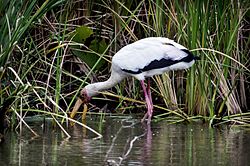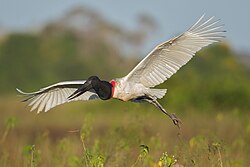
Ciconiidae is a family of heavy-bodied, large-billed wading birds in the monotypic order Ciconiiformes. Most species in the family are called storks, although some have different common names: two species in the genus Anastomus are known as openbills, two from the genus Leptoptilos are called adjutants, and three species are called jabiru. [1] Storks are found in tropical and subtropical habitats around the world, mostly inhabiting wetlands and marshes, although some also inhabit forests and savannah. [2] [3] They are large birds with long legs, stout bills, and variable featherless patches on the head. The beaks of storks can be highly specialised depending on their function, as exemplified by the openbills, whose bills possess a gap between the mandibles to help capture freshwater snails. [4]
Contents
Storks are threatened by habitat loss, pesticide use, and intentional hunting. [2] Four species of stork—the milky stork, oriental stork, greater adjutant, and Storm's stork—are classified as being endangered on the IUCN Red List, while a further three are considered near-threatened and one is considered vulnerable. However, the conservation statuses of many species of stork seem to be based on mistaken assumptions and limited data, such as underestimating the ability of species to use agricultural land. Many species may consequently warrant a data deficient listing until more information about their ecology is available. [5]
There are currently 20 extant species of stork recognised by the International Ornithologists' Union, distributed among 6 genera, 1 of which is monotypic. [1] The order Ciconiiformes previously also included the herons (Ardeidae) and ibises and spoonbills (Threskiornithidae), but these have since been reassigned to other orders. [2] The storks are most diverse in Afro-Eurasia, especially in Africa and Asia, and only three species, including the wood stork, are known from the Americas. [3] [5] Many species of fossil stork are also known from the Oligocene onwards; however, their exact number and taxonomy are unsettled due to ongoing discoveries. [6]


























